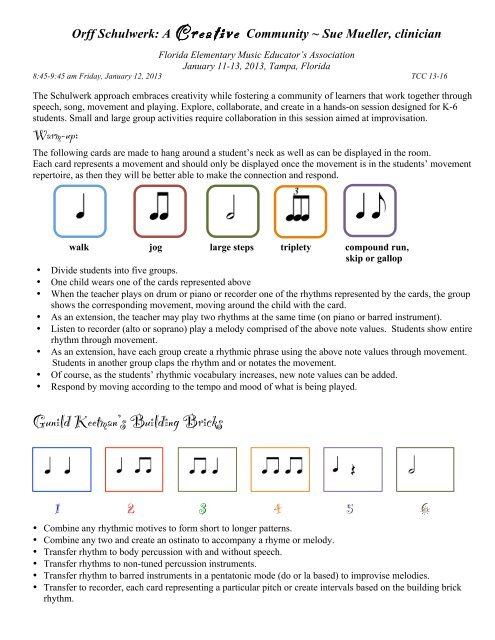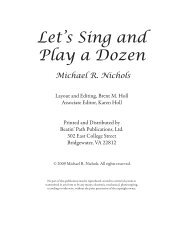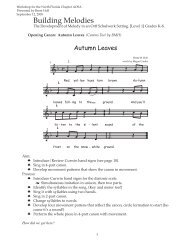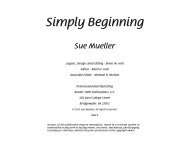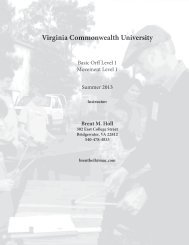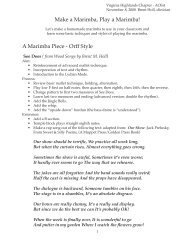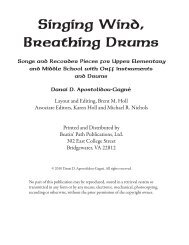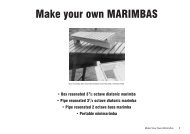Orff Schulwerk: A Creative Community - Florida Music Educators ...
Orff Schulwerk: A Creative Community - Florida Music Educators ...
Orff Schulwerk: A Creative Community - Florida Music Educators ...
Create successful ePaper yourself
Turn your PDF publications into a flip-book with our unique Google optimized e-Paper software.
<strong>Orff</strong> <strong>Schulwerk</strong>: A <strong>Creative</strong> <strong>Community</strong> ~ Sue Mueller, clinician<br />
<strong>Florida</strong> Elementary <strong>Music</strong> Educator’s Association<br />
January 11-13, 2013, Tampa, <strong>Florida</strong><br />
8:45-9:45 am Friday, January 12, 2013 TCC 13-16<br />
The <strong>Schulwerk</strong> approach embraces creativity while fostering a community of learners that work together through<br />
speech, song, movement and playing. Explore, collaborate, and create in a hands-on session designed for K-6<br />
students. Small and large group activities require collaboration in this session aimed at improvisation.<br />
Warm-up:<br />
The following cards are made to hang around a student’s neck as well as can be displayed in the room.<br />
Each card represents a movement and should only be displayed once the movement is in the students’ movement<br />
repertoire, as then they will be better able to make the connection and respond.<br />
walk jog large steps triplety compound run,<br />
skip or gallop<br />
• Divide students into five groups.<br />
• One child wears one of the cards represented above<br />
• When the teacher plays on drum or piano or recorder one of the rhythms represented by the cards, the group<br />
shows the corresponding movement, moving around the child with the card.<br />
• As an extension, the teacher may play two rhythms at the same time (on piano or barred instrument).<br />
• Listen to recorder (alto or soprano) play a melody comprised of the above note values. Students show entire<br />
rhythm through movement.<br />
• As an extension, have each group create a rhythmic phrase using the above note values through movement.<br />
Students in another group claps the rhythm and or notates the movement.<br />
• Of course, as the students’ rhythmic vocabulary increases, new note values can be added.<br />
• Respond by moving according to the tempo and mood of what is being played.<br />
Gunild Keetman’s Building Bricks<br />
1 2 3 4 5 6<br />
• Combine any rhythmic motives to form short to longer patterns.<br />
• Combine any two and create an ostinato to accompany a rhyme or melody.<br />
• Transfer rhythm to body percussion with and without speech.<br />
• Transfer rhythms to non-tuned percussion instruments.<br />
• Transfer rhythm to barred instruments in a pentatonic mode (do or la based) to improvise melodies.<br />
• Transfer to recorder, each card representing a particular pitch or create intervals based on the building brick<br />
rhythm.
One: A book celebrating who we are as individuals and working together in a supportive way.<br />
Using the children’s book One by Kathryn Utoshi, each group will improvise/create their own melody using the<br />
above Building Bricks. Melodies may be played on recorder, sung, or on barred instruments.<br />
Students will also use cooperative learning strategies:<br />
• Discussion: Active, face-to-face interaction; values individual differences and collaboration.<br />
o A talking stick facilitates sharing the decision-making.<br />
• Positive Interdependence: Team members need each other to share and complete the task at hand.<br />
• Personal Responsibility: Each member is important and accountable for helping to complete the task.<br />
• Collaboration, Working Together: Staying on task, summarizing and recording ideas<br />
• Group Reflection and Processing: Assessing how well group worked together to complete the task<br />
Improvise and then create melody and movement that characterizes the following colors/numbers:<br />
Blue (6) – quiet<br />
Yellow (2) – sunny<br />
Green (3) – bright<br />
Purple (4) – regal<br />
One (1) – funny<br />
Orange (5) – outgoing<br />
Red (7) – hot<br />
Tasks: Groups are named according to the colors above, but may certainly add words to help build team spirit.<br />
1. Create a rhythm that is 8 - 16 beats (in duple meter) or 12 – 24 beats (in triple meter).<br />
2. Group practice on body percussion first.<br />
3. Decide on do or la based melody (major or minor sound), or mode (Dorian or Lydian would work).<br />
4. Group improvises using rhythm in decided mode.<br />
5. Group members take turn, each member contributing at least 4 beats of the melody. Whole group supports<br />
and discusses each contribution until a melody has been created.<br />
6. Decide what instrument(s) the melody should be played on. Should it be accompanied<br />
7. Group determines the tempo and any expressive elements that need to be added to the music.<br />
8. Decide on movement.<br />
2<br />
6 <br />
5<br />
6 <br />
3<br />
6 <br />
6 <br />
4<br />
6 <br />
7<br />
6 <br />
Many thanks to West <strong>Music</strong> Co. and Beatin’ Path Publications for their support of this session.


